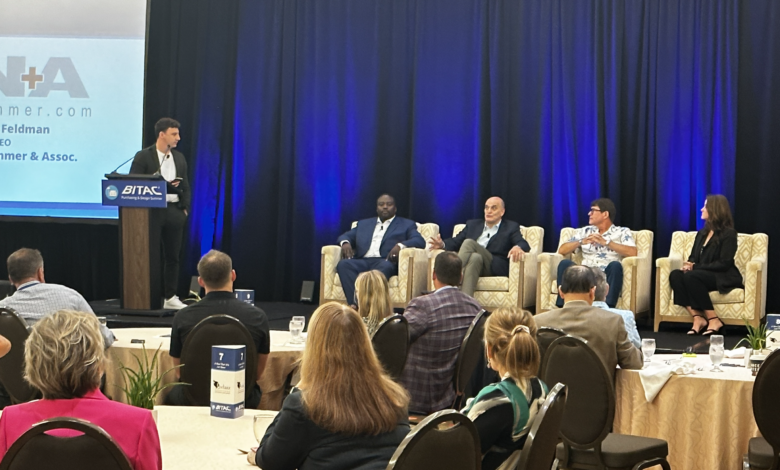
BITAC 2024 Purchasing & Design Summer Panel Discussion: The Impact of Technology on Hospitality Purchasing and Design
By Gavin Fraser | July 23, 2024
The evolving landscape of hospitality design was recently explored at a panel moderated by Gavin Fraser, Editor at Hotel Interactive. Featuring insights from industry leaders like Alicia Husband, Warren Feldman, Tom Haines, and Adam Butts, the discussion delved into current customer behavioral trends and the impact of technology on design and operations.
Customer Behavioral Trends
Alicia Husband, Founding Principal of Alicia.Design Collective, highlighted a shift towards customer-centric design preferences: “Clients want responsiveness. Design trends are diverse, but lifestyle experiences and high-end aesthetics at budget-friendly costs are paramount.”
Tom Haines, Vice President of Operations at Mainsail, emphasized the popularity of lifestyle properties: “We create interactive, socially engaging environments with features like live culinary theaters. Our goal is to enhance the lifestyle experience and drive revenue metrics.”
Warren Feldman, CEO of NEHMAR & HVS Design, discussed financial constraints post-pandemic: “Instead of planning a complete property renovation, many are opting to refresh their properties selectively, aiming to extend the lifespan of certain elements to save costs.”
Adam Butts, Head of Procurement at Crescent Hotels, observed guest preferences for boutique and locally infused experiences: “Everyone is now looking for boutique hotels and unique experiences. They (the guest) want something different, with a unique look and feel. Even within some of the brands, there’s a desire to incorporate something distinctive and bring in local flavor.”
Technology in Hospitality Design
Alicia Husband spoke about how AR/VR has enhanced the design and purchasing process and how important it has been for her deliverables: “We love that part of it (The use of AR/VR). We conduct virtual walkthroughs after assembling 3D renderings. Clients have access to static imagery and the chance to walk through a space. We’ve completed several boutique hotels where you can enter through the front door, proceed to the front desk, take the elevator up, and then visit your guest room. This approach really gives clients who may struggle with visualization the opportunity to experience everything firsthand.”
The panel explored the transformative impact of technology on hospitality design and operations. Adam Butts highlighted technologies role in the in-room guest experience: “From the lights to ordering services, everything can be managed from the TV and your phone serves as the remote. That’s where everything is headed—using and integrating technology effectively through the TV, allowing guests to handle everything comfortably from their beds.”
Warren Feldman discussed challenges in technology integration within hotel rooms: “As a tool for designers to generate ideas, AI is excellent. However, in the end, designers still need to curate and refine these ideas. AI allows for faster editing and presentation of images to clients than older rendering programs, streamlining the design process. It’s crucial to use AI as a tool to enhance what you’re already conceptualizing in your mind.”
Tom Haines emphasized collaboration across disciplines: “I agree with everything that Adam said. It really is about the TV. I think we were trying to make the rooms too complicated, and when you have people from varying demographics, it just wasn’t working for everybody. Everyone knows how to use the TV and the digital telephone. So, I think that’s where it works.”
Data Analytics and Procurement
The panel discussed the role of data analytics in shaping purchasing decisions. Tom Haines stressed the value of guest feedback: “Guest insights are crucial for refining design and operations to meet evolving expectations.”
Adam Butts highlighted the role of e-procurement in streamlining processes: “When it comes to generating purchase orders, receiving events, and handling the accounts payable side of things, talking to different people at the hotel who use it and showing them how it can cut their time in half for purchasing and payment through E-procurement is crucial. Making sure they understand the implementation of it is extremely easy. However, the main challenge we’re facing right now is the adoption rate. Many believe it’s difficult and tedious, which stems from lack of training.”
Tom Haines, spoke to the same challenge: “Getting those operations people on board is the biggest challenge—breaking the old habits. That’s relatively new to us, and it’s training; it’s breaking people out of their old ways. It’s about getting the right system and then training people to work with it.”
Future Directions
Looking ahead, Warren Feldman shared insights into upcoming design trends: “Smart technologies will enhance guest convenience while maintaining simplicity. Collaboration will be key to successful implementation.”
In conclusion, the panel provided a comprehensive overview of how technology, customer insights, and collaborative strategies are reshaping hospitality design. By prioritizing guest-centric solutions and leveraging data-driven insights, hospitality professionals can navigate challenges and capitalize on emerging opportunities in the industry.




Get involved!
Comments